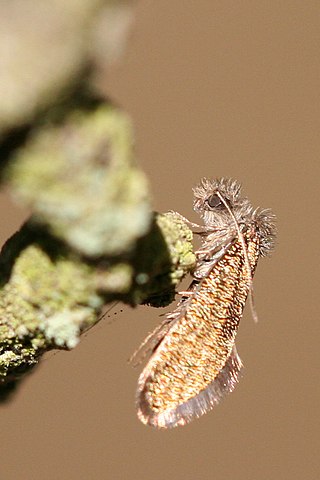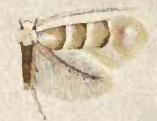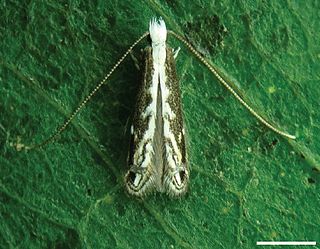
Dyseriocrania subpurpurella is a diurnal moth from the family Eriocraniidae, found in most of Europe. The moth was first named by the English entomologist, Adrian Hardy Haworth in 1828.

Caloptilia azaleella is a moth of the family Gracillariidae. It is endemic to Japan, but has been introduced worldwide, wherever there are Azaleas.

Prays fraxinella, also known as the ash bud moth, is a moth of the family Plutellidae found in Europe. The larvae are leaf miners, feeding on the leaves and buds of ash trees.

Eriocrania sangii, the large birch purple, is a moth of the family Eriocraniidae found in Europe and described by John Henry Wood in 1891. The moth can be found flying in sunshine around birch trees and the larvae feed on birch leaves.

Eriocrania unimaculella is a moth of the family Eriocraniidae found in Europe. It was first described by the Swedish naturalist Johan Wilhelm Zetterstedt in 1839. The larvae feed inside the leaves of birch, making a mine.

Parornix anglicella is a moth of the family Gracillariidae found in Asia and Europe. It was described in 1850, by the English entomologist Henry Tibbats Stainton, from a specimen from Lewisham, Kent.

Ectoedemia intimella is a moth of the family Nepticulidae which is found in Europe. It flies in June and July and the larva mine the leaves of willows from July to November.

Stigmella cypracma is a species of moth of the family Nepticulidae. It is endemic to New Zealand and has been observed in the North and South Islands. The larvae of this species are leaf miners and pupate within their mines. The larval host species is Brachyglottis repanda. Adult moths are on the wing in February and September to November. This species has two generations per year.

Stigmella fulva is a moth of the family Nepticulidae. It is endemic to New Zealand and has been observed in the North Island around Mount Taranaki, in the South Island and at Stewart Island. The species' eggs are laid singly but a considerable number may be deposited on the upper surface of one leaf. The incubation period can last from a week to a month depending on climatic conditions. The larvae mine the leaves of their host plants which are all in the genus Olearia. Larvae have been recorded in all months except January, February and June. The cocoon is brown and spun amongst the leaf litter under its host plant. The pupal period has been shown to range from 21 days to 79 days, again depending on climatic conditions. Adults have been observed on the wing January until March and August to December. They are active in the sun about their larval food plant.
Ectropina raychaudhurii is a species of moth of the family Gracillariidae. It is known from Tamil Nadu, India.

Phyllonorycter caryaealbella is a moth of the family Gracillariidae. It is known from Georgia, Kentucky, Wisconsin and Florida in the United States.

Phyllonorycter lucetiella is a moth of the family Gracillariidae. It is known from Québec in Canada and Illinois, Kentucky, Pennsylvania, Florida, Georgia, Maine, Maryland, Michigan, New York, Vermont, Connecticut and Massachusetts in the United States.

Phyllonorycter symphoricarpaeella is a moth of the family Gracillariidae. It is known from Kentucky, Ohio, Texas, California and Maine in the United States.

Phyllonorycter tiliacella is a moth of the family Gracillariidae. It is known from Canada and the United States.

Cremastobombycia solidaginis is a moth of the family Gracillariidae. It is known from Ontario and Quebec in Canada, and Florida, Texas, Georgia, Kentucky, Maine, Maryland, Massachusetts, Connecticut and Michigan in the United States.

Conopomorpha flueggella is a moth of the family Gracillariidae. It is known from Tianjin, China.

Macrosaccus gliricidius is a moth of the family Gracillariidae. It is known from Central America and the West Indies.
Metriochroa symplocosella is a moth of the family Gracillariidae. It is found in Hunan, China.

Spinivalva is a genus of moths in the family Gracillariidae. It contains only one species, Spinivalva gaucha, which is found in Brazil.

Micrurapteryx caraganella is a moth of the family Gracillariidae. It is found in Siberia, and possibly Tajikistan and the Russian Far East.











